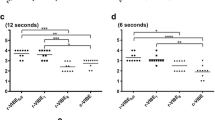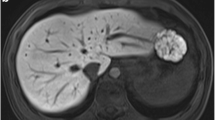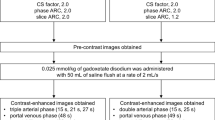Abstract
The purpose of this study was to determine an optimal flip angle for T 1-weighted images on abdominal examination by comparing the signal-to-noise ratio (SNR) and contrast-to-noise ratio (CNR) depending on the change in flip angle based on the volumetric interpolated breath-hold examination (VIBE) technique. The subjects in this study included 50 patients (20 men and 10 women; average age, 60 years) who visited the hospital between October 2009 and March 2010 to receive an abdominal magnetic resonance imaging (MRI) examination. Among the 50 patients, there were 27 patients with hypervascular hepatocellular carcinomas (HCCs) and 23 patients with hemorrhagic HCCs. A 3 T MR scanner (Magnetom Tim Trio; Siemens, Germany) with a 12-channel body coil was used. For the pulse sequence, the VIBE (time of repetition TR, 3.18 ms; time of echo TE, 1.16 ms; matrix, 384 × 307; slice thickness, 3 mm; field of view FOV, 380 mm; bandwidth BW, 720 Hz) and breath-hold examination with an examination time of 19 s were used. Images of the axial and coronal planes at three flip angles (10°, 25°, and 35°) were obtained. Based on the images obtained, the signal intensities of the liver, lesions, and background noise were measured and the SNR and CNR were calculated. For evaluation of the optimal flip angle, SPSS for Windows (version 17.0) was used to conduct the non-parametric Kruskal–Wallis test. The SNRs for hypervascular and hemorrhagic HCCs, depending on changes in flip angle of the VIBE, were 11.12 ± 0.98, 10.83 ± 1.44, and 9.61 ± 1.66, and 76.00 ± 6.43, 43.32 ± 5.89, and 30.45 ± 4.27 at angles of 10°, 25°, and 35°, respectively. The CNRs were 14.83 ± 0.12, 7.38 ± 0.41, and 5.70 ± 0.66, and 3.95 ± 0.21, 2.42 ± 0.58, and 1.69 ± 0.93, respectively (p < 0.05). At a flip angle of 10°, the SNR and CNR were the highest. When the flip angles were 25° and 35°, the contrast of the image, as well as the SNR, were shown to have a downward trend (p < 0.05). A flip angle of 10° is considered to be useful for the optimal T 1-weighted image to detect HCC in the three-dimensional VIBE abdominal MRI technique.


Similar content being viewed by others
References
N.M. Rofsky, J.C. Weinreb, M.A. Bosniak, R.B. Libes, B.A. Birnbaum, Radiology 180, 85–89 (1991)
Y. Yamashita, T. Miyazaki, Y. Hatanaka, M. Takahashi, J. Comput. Assist. Tomogr. 19, 759–765 (1995)
V.S. Lee, M.T. Lavelle, N.M. Rofsky, G. Laub, D.M. Thomasson, G.A. Krinsky, J.C. Weinreb, Radiology 215, 365–372 (2000)
N.M. Rofsky, V.S. Lee, G. Laub, M.A. Pollack, G.A. Krinsky, D. Thomasson, M.M. Ambrosino, J.C. Weinreb, Radiology 212, 876–884 (1999)
H.Z. Wang, S.J. Riederer, J.N. Lee, Magn. Reson. Med. 5, 399–416 (1987)
J. Frahm, A. Haase, D. Matthaei, J. Comput. Assist. Tomogr. 10, 363–368 (1986)
S.G. Wetzel, G. Johnson, A.G. Tan, S. Cha, E.A. Knopp, V.S. Lee, D. Thomasson, N.M. Rofsky, Am. J. Neuroradiol. 23, 995–1002 (2002)
N. Karabulut, D.R. Martin, M. Yang, T.J. Tallaksen, Am. J. Radiol. 179, 1225–1233 (2002)
A. Huppertz, S. Haraida, A. Kraus, C.J. Zech, J. Scheidler, J. Breuer, T.K. Helmberger, M.F. Reiser, Radiology 234, 468–478 (2005)
A. Haase, J. Frahm, D. Matthaei, J. Magn. Reson. 67, 258–266 (1986)
E.C. Unger, M.S. Cohen, R.A. Gatenby, M.R. Clair, T.R. Brown, S.J. Nelson, J.S. McGlone, J. Comput. Assist. Tomogr. 15, 578–584 (1991)
S.H. Chung, M.J. Kim, J.Y. Choi, H.S. Hong, J. Magn. Reson. Imaging 31, 365–372 (2010)
Author information
Authors and Affiliations
Corresponding author
Rights and permissions
About this article
Cite this article
Goo, EH., Kweon, D.C., Dong, KR. et al. Flip Angle for the Optimal T 1-weighted Image in the 3-D Volumetric Interpolated Breath-hold Examination Abdominal Magnetic Resonance Imaging Technique. Appl Magn Reson 40, 221–229 (2011). https://doi.org/10.1007/s00723-011-0199-3
Received:
Published:
Issue Date:
DOI: https://doi.org/10.1007/s00723-011-0199-3




